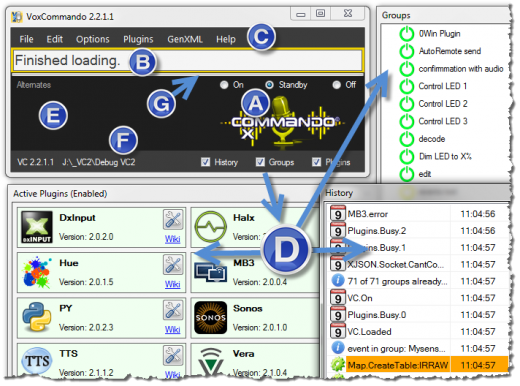Difference between revisions of "How to use VoxCommando"
m (1 revision) |
m (1 revision) |
(No difference)
| |
Latest revision as of 11:24, 13 January 2021
Redirect to:
Installation
If you need help installing VoxCommando click here: installation.
Depending on the media application(s) you are planning to use with VoxCommando, you may need to adjust some options to allow for proper communication between the programs. The installation wiki page and the video tutorials provide more information in this regard.
Video Tutorials
Various tutorials are available on the VoxCommando Tutorials playlist.
Also useful for new users are the Fireside Chat videos.
The Basics
As the program's name indicates, VoxCommando relies on commands that you issue in order to control your programs and devices.
Note that for VoxCommando to function properly you will need to have a decent microphone setup and the appropriate language settings. Be sure to review these concepts starting from the FAQ if you're having problems with your initial setup. You can also consult the video tutorials or search the user forum.
You can see a full list of the commands that have been defined in your particular installation using Help > Generate Help Menu. This will open a web browser window and display the existing voice commands.
It is always possible to modify the existing commands, add other command sets for other utilities, and to create your own commands from scratch.
If you want to create or customize your own commands see Customizing Commands to explore this topic.
Understanding the main window interface
(A) Mode Buttons
- Green = On - performing commands
- Yellow = Standby - not performing commands but listening
- You can tell VC to listen and it will switch to Green mode
- Using prefix mode you can still execute commands by first saying the prefix (select this in Options)
- Red = Off - VC is not listening at all (no CPU usage) but is ready to switch modes instantly (command language model is in memory)
- When the mode changes, the background color will change to match the mode
- The icon will also change in the window, on the taskbar and in the notification area
- The mode can be changed by clicking these buttons, but also by other methods
(B) Command Text
- The current or last thing VC heard you say, followed by the Confidence (%)
- This shows how confident VC is that it heard you correctly. While you are still speaking, "guesses" will be displayed here.
- In the Options, you can set the minimum confidence required before VC will execute your command. If the confidence is lower than the minimum you set, the command will be ignored.
(C) Main Menu
Many settings and tools for using and customizing the VoxCommando experience can be accessed via the main menu. See Main Menu for more details.
(D) Tabs: History / Groups / Plugins
By default the History tab is selected.
History
- This panel shows a summary of things as they happen. It is basically a user-friendly log. A single voice command may result in multiple items appearing in the history. When building your own commands in the command tree editor, it is also possible to drag events from this history window into your new command (a convenient way to ensure the correct syntax is used).
- You can use the small icon at the top right to clear the list if you wish, but the list will only store the 30 most recent commands.
Groups
Shows a list of all groups of commands that have been loaded. Groups that are currently enabled are shown in green groups that have been disabled are shown in red.
- You can manually toggle groups on and off by clicking on them, or with various other methods.
Plugins
- This panel shows which plugins have been enabled and their version number.
- You can double-click on plugins listed here to open and edit their settings.
- You can also access plugin settings from the main menu
- Plugins can be enabled and disabled in options
(E) Alternate Commands
- Sometimes your command may sound like a few different things, or you may have multiple commands that use identical phrases.
- example: if you say "play artist Jack" it won't know which bob you mean if you have songs by Jack Johnson and songs by Jack White
- When this happens, all the probable commands will show up here.
- VoxCommando will display these alternates in a popup window if you have selected "Show OSD Alternates" in the Options window.
- You can then say "Option 3" and VC will execute the 3rd command in this list.
(F) Version / Path / Volume Meter
- The current version of the program is shown at the bottom left
- Followed by the path. This can be a helpful reminder if you use multiple configurations of VoxCommando in different folders, either for testing purposes or for different tasks/situations/users.
- Volume Meter
- This is primarily used to verify that your microphone is working.
- Normally the meter should only move slightly.
- When you speak loudly the meter should still only move to about 1/3 of the maximum or less.
(G) Learn Checkbox
Allows you to train the speech engine to recognize your voice. We recommend you leave this unchecked (off) except when you are training the system in a quiet environment and correctly saying commands. Otherwise the system may learn incorrectly.
